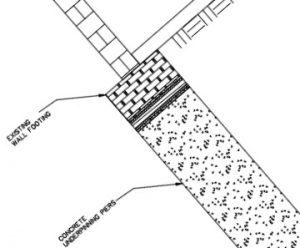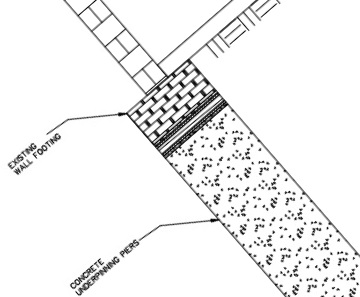An environmental consultant I know once showed me a photograph of a deep excavation he had visited on a site tour. The excavation had required underpinning of a couple of brick, bearing wall buildings on the lot lines. Underpinning is the term applied to a variety of methods used to resupport a structure’s foundation, usually to a deeper bearing depth. Generally, underpinning is performed if the foundation system for an existing structure is compromised or if foundation support needs to be transferred to a deeper level to allow work that would otherwise cause foundation movement and damage to the structure. The latter scenario is common when a new building is built adjacent to an existing one. Owners of buildings that are to be underpinned as part of adjacent construction need to know what is involved. Underpinning by a third party constructor carries with it technical and legal implications and exposes the owner to risk that may not be managed by the adjacent construction project owner and their contractors and professionals in a manner optimal to the building owner.

Underpinning can take a variety of forms. Pier underpinning is the most common and is typically used to transfer the support of wall footings to a deeper level. A wall or column can be picked up by needle beams, spanning between temporary foundations, which provide support while the existing foundation is replaced. Several pile systems can be used for underpinning, as well. Micropiles are commonly used for underpinning, either drilled through existing foundations or attached to the existing structure with retrofit pile caps. In soft soils, segmental piles can be jacked in, using the existing structure to resist the jacking forces. Other pile types can be attached to a structure using fabricated or manufactured brackets. In some cases, ground improvement methods, like jet grouting, can be used for underpinning.
For the project described previously, it appeared as if the contractor had come up with a two-stage, intermittent pier underpinning system (combining two higher-risk practices) and had only caused minor damage to the buildings. Fortunately, the building’s occupancy (if there was one) was not sensitive to the damage, so the contractor apparently considered it to be a success.
Indifference to the risks related to underpinning, and abutting structures generally, is a common attitude and it is a routine source of damage claims by abutters to construction projects in urban areas. Like sidewalk sheds and excavation support, underpinning systems are protective measures used to protect workers and the public from construction hazards. As a result, it is considered to be among the contractor’s “means and methods” and are often deprecated by the design team and building officials because they are temporary. Some geotechnical engineers take the attitude of “let the contractor figure it out” and do not provide underpinning recommendations. Structural engineers on typical building projects do not always show underpinning requirements on the drawings or provide even a basic performance specification. Typically, if there are no contract documents for underpinning, the design team will not review underpinning plans, since they lack expertise with these systems. Consequently, oversight of underpinning may be minimal until a problem occurs.
The lack of respect given to temporary structures in construction is of concern for all protective systems, but underpinning is different. Unlike roof protection and most excavation support systems, underpinning it is not temporary. Once installed, an underpinning system is part of a structure’s foundation system, usually for the rest of the life of the building. Therefore, in addition to loads from any temporary stages, underpinning must provide a durable load path for all loads to which the underpinned structure is subjected, including wind and seismic loads.
Most underpinning systems are deceptively simple on paper; a new foundation element is added below an existing foundation and the excavation can proceed without destabilizing the existing structure. Foundation support is transferred to a deeper level, which should be more competent. In reality, underpinning a building without causing damage requires consideration of the behavior of the existing structure, the sequence of construction and the time-dependent and sometimes complex load and support conditions that result from transferring the weight of the structure from one foundation system to another.
Underpinning construction subjects an underpinned structure to risk of damage that is inherent to the methodology. The existing structure has to deform and the underpinning had to settle to transfer loads to the ground through the new foundation elements. Deformation and settlement will occur until equilibrium is reached, which depends on the competency of the bearing stratum and the quality of construction. If the movement of the structure is sufficiently large or nonuniform, damage will occur. Since this effect is cumulative, the risk of damage is substantially increased when a staged underpinning system (i.e. underpinning of the underpinning) is used. Preloading the underpinning, using jacking or wedging, will mitigate settlement, but cannot eliminate it without the risk of lifting the structure, which can also be damaging. Supporting a continuous element, like a bearing wall, with discrete elements, like intermittent piers or piles can produce a non-uniform support condition and induce tension in the wall that it is not designed to resist.
The changing and sometimes complicated loads that are common in underpinning are not always understood by underpinning designers and contractors. This exacerbates the risks already inherent to underpinning. Unfortunately, the barriers to entry for designing underpinning can be low, resulting in low-end designers being somewhat ubiquitous. I once saw a one-page underpinning “plan” prepared by a materials testing firm, which consisted of a generic underpinning section intended for multiple structures abutting the deep rock excavation for a mixed-use high-rise in Manhattan. Several years ago, I heard a New York City building official describe encountering a chemical engineer preparing underpinning plans on his kitchen table. Low-cost underpinning design is attractive to inexperienced and unsophisticated contractors, who do not understand the risk they are assuming, as well as those who just want a “permission slip” to improvise their underpinning details in the field.
Those who consider underpinning to be nothing more than “means and methods” would not take exception to a contractor buying or preparing a generic underpinning design and working out the details in the field. In this scenario, the contractor assumes the risk and reward associated with the underpinning design. If the underpinning does not perform adequately, the contractor and designer would be liable for damages. However, poorly designed or improvised underpinning increases the risks for the owners and residents of adjacent buildings, as well as for the project owner and design team, likely without the knowledge and consent of those parties. In the event of a failure, the abutters could lose value and use of their properties. The project owner and design team would almost certainly be party to any resulting claims and incur defense costs, as well as consequential costs like construction delays. These losses may not be fully recoverable.
Managing the risk from underpinning requires that the potential hazards be taken seriously. Project owners need to understand that an underpinning failure can threaten the success of the project and, therefore, provide proper budgets to manage this risk in both the design and construction phases.
The design team should consider underpinning requirements, including alternatives to underpinning, during the design development process. Construction documents should provide basic performance specifications and require the contractor to provide submittals to demonstrate conformance with the specifications. Depending on the make-up of the design team, a specialty consultant may need to be retained to assist with this. Finally, the owner of a building that is to be underpinned should require that underpinning plans be submitted to them for review by their independent consultant as part of any license agreement.
As cities are revitalized and densified, the need for new buildings to abut existing construction will continue to require underpinning. For these projects to be viable, it is necessary that project teams and building official require that best practices be proactively implemented in the design and construction of underpinning. For this to happen, underpinning will have to be considered as something more than contractor “means and methods” and given respect and consideration that is commensurate with the risk involved. This includes recognizing that underpinning is a type of specialty construction that should be the domain of properly qualified designers and contractors.
The information and statements in this document are for information purposes only and do not comprise the professional advice of the author or create a professional relationship between reader and author.
